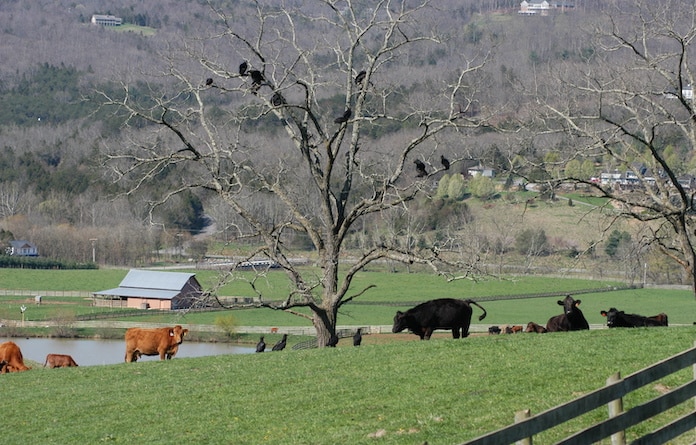Black vultures a problem for cattle farmers

Calving season poses its own challenges for livestock raisers, but a new problem has been plaguing cattle farmers around Monroe County: black vultures.
Black vultures will kill and consume young livestock. That is different than the redheaded turkey vulture, which will only feast on carrion, or the corpses of animals.
Black vultures have been known to attack vulnerable calves, piglets and lambs, and in some cases even destroy property.
According to USDA Wildlife Services Program’s Illinois State Director Scott Beckerman, reports of cattle raisers struggling with black vulture conflicts have been increasing as these birds expand their range into Illinois.
“In the winter, … the birds typically migrate south to escape the extremely cold weather,” Beckerman said. “But, as we see warming trends in our winters, we see that their population is expanding northward, so they stay longer in our state and arrive sooner in the spring each year. In some years in Southern Illinois, now they are staying all winter.”
Teresa Steckler, University of Illinois extension agricultural natural resources and commercial agriculture educator, said she really began to notice conflicts ramp up in the region five years ago when she received a report from a cattle raiser in Murphysboro.
Around this time, Gary Gilbert of Double G Simmentals also began losing young calves to the black vultures. Gilbert raises calves in Fults, Maeystown and Red Bud, and his father has a pasture close to his in Maeystown.
Last year, his father lost about five calves to the black vultures, while Gilbert has lost an average of one calf per year.
Gilbert said the cows alone often cannot fight off the black vultures. He has seen swarms of them target calves, sometimes even laying in wait while a mother is giving birth.
“Basically, the (mother cows) just try chasing them off of it,” Gilbert said of the black vulture attacks he’s witnessed. “These things are smart though. They’ll want to go after a calf and then (the mother cow) will spin around and chase it off, but then another will come back and go after the calf … It’s pretty hard for a cow if she has five, six, seven, eight, nine, 10 of those things trying to get to her baby. When these things get together and hunt in a pack like that, the (mother cows) can only do so much.”
Steckler said young black vultures are taught these aggressive behaviors from older members of the population, therefore causing attacks to continue.
“These black vultures teach subsequent generations the predatory behavior that they have,” Steckler explained. “I have seen them in Arkansas land on the back of the cow that is in the middle of calving (when) the calf is halfway out the birth canal and start attacking the calf then. Birds that are around will pick up on that bad behavior and it’s a behavior that gets perpetuated within the population.”
While a farmer’s first reaction to black vultures attacking their livestock may be to kill them, black vultures are protected by the federal Migratory Bird Treaty Act as well as state laws. Permits allowing the use of lethal force to protect livestock can be obtained, but only after other options are exhausted.
Livestock raisers are not alone in efforts to protect vulnerable livestock. A large-scale research project with the National Wildlife Research Center is working to develop new tools to help minimize losses. Because of funding from the U.S. Fish and Wildlife Service, Beckerman’s office is able to investigate losses and help producers form strategies to protect their animals.
Beckerman said the first step is to conduct an assessment to determine if the black vultures are really causing the deaths. He said this starts with phone calls and exchanging pictures of potential evidence, and if he cannot determine the cause of death or if he believes black vultures are the culprit, he will arrange to visit the site.
This detailed assessment is important as merely seeing what appears to be a black vulture near livestock does not necessarily prove vultures caused the death, Beckerman said. Young eagles resemble black vultures and may be mistaken for them. Additionally, black vultures also feast on carcasses, so the animal may already have been dead before the black vultures arrived.
There are a few things Beckerman looks for during the assessment.
“Generally, when black vultures are a culprit in the death, we will see that the eyes are the first things that they peck out (while) the animal will still be alive,” Beckerman said. “Once the animal is blind, then they will begin to forage on it while it’s still alive and a lot of times they may go in the rectum (or) the anus first. So, we look for evidence around the eyes that the animal was actually alive when they were pecking there; We’re looking for contusions and hemorrhaging around the eyes.”
If it is determined that black vultures are preying on live animals, Beckerman said it is time to develop an integrative damage management plan.
“You utilize a multitude of tools that together are more likely going to be successful at stopping the problem than if you just take one thing and you try that,” Beckerman said of integrative damage management plans. “With vultures, if you just take one tool and try it, most times they adapt, they habituate, and then you’ve lost that tool’s effectiveness.”
When combined, habitat modification, good husbandry, exclusion practices and harassment and dispersal methods can make all the difference, Beckerman said.
Keeping pregnant livestock in sheds or buildings and close to human activity can help, but Beckerman realizes this form of exclusion is not always possible for those with large-scale operations. As detailed in an USDA-WS informational packet on vultures, other exclusionary practices such as placing traditional bird spikes on perching spots are not likely to deter vultures. However, producers may have better luck with installing electric tracks so the birds receive a mild, harmless shock when they attempt to perch.
Part of good husbandry is ensuring livestock are in a clean environment, meaning there are not any carcasses left around the pasture. Carrion from nearby roads is enough to lead black vultures to pastures.
“We’re recommending people look at the public roads along their pastures and if they see roadkill that they properly dispose of that so that they don’t have the vultures foraging on a road right next to the pasture where they’re calving or lambing,” Beckerman said, later adding, “I’m not telling everybody to … drive all the roads and get rid of all the roadkill, but if you’ve got vulnerable stock around and you know you’ve had vultures around (or if) you think you have had problems, then you better go to the next step: improve your husbandry.”
Because vultures cannot easily glide through leafy trees, it’s important to remove any dead trees from around pastures, Beckerman said. This ensures they do not have the opportunity to perch and watch the livestock.
Steckler said many producers try to make the vultures disperse by chasing them away, but this is only a temporary fix.
“The interesting thing is you can actually chase them away,” Steckler said. “Say your pasture is 100 yards from your house. As soon as (the black vultures) hear the side-by-side or your truck, they will leave. But as soon as you go back and turn it off, they will come back. They are highly intelligent for a bird and they learn things quickly.”
Other common dispersal methods include guard dogs, propane cannons, pyrotechnics, lasers and shooting shotguns in the air – not at the birds – to scare them.
In order for the birds not to habituate to propane cannons, Beckerman said producers must vary their locations. He also stressed the importance of notifying one’s local conservation police officers if they are using shotguns to scare the birds so the officers do not assume they are breaking the laws and harming the birds. Some producers purchase effigies to scare the birds, however, Beckerman warned this works for small pastures only.
If the recommended cocktail of prevention methods does not work, Beckerman’s agency will recommend the producer obtain a special permit from the U.S. Fish and Wildlife Service that allows them to shoot and kill a few black vultures. There is an application fee of $100, and documentation of failed prevention methods is required.
The producer will also need an Illinois Department of Natural Resources Nuisance Animal Permit, which can be obtained at no extra cost. Both are valid through March 31 of the following year and must be renewed annually.
Beckerman recommends those who obtain the permits hang up the dead carcasses as a scare tactic.
In addition, those who have lost livestock to black vultures may be eligible to receive 75 percent of average market value for lost livestock through the USDA Farm Service Agency Livestock Indemnity Program. Call 217-241-6600 for more information.
Steckler said she cannot stress the importance of being proactive when dealing with black vultures enough, the biggest factor in this being reporting cases of depredation to the state U.S. Department of Agriculture and Wildlife Services Program offices.
“We need documented cases so that the federal government realizes that, yes, the black vultures are also becoming an issue in the state of Illinois, and cattlemen need to step up and apply for permits, and have appropriate people come and help them so that it gets documented and the awareness is increased at the federal level,” Steckler said.
Those who believe they may be experiencing black vulture depredation can contact Beckerman’s office at 1-866-4USDAWS.






